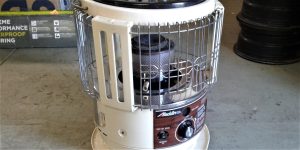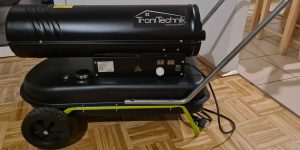Are you looking for the best ventless garage heaters? Perfect choice since few devices will do better than ventless heaters as they operate at around 99.9% efficiency.
Ventless heaters take the oxygen they require for the burning process from the air inside the garage and then vent it back once it gets heated. Because there is no exchange of indoor and outdoor air (that’s when most heaters lose their heating capacity), the ventless heaters have become one of the most efficient heating systems.
I will review some vent-free heaters for the garage and give you hints on what features to consider to get the most suitable product.
| Name | Fuel type | Heating area | Heating capacity | Heat type | Review |
|---|---|---|---|---|---|
| Mr. Heater VF30KBLUELPbest propane heater | propane | 1000 sq.ft. | 30000 BTU | blue flame | Review |
| Mr. Heater MHVFRD10LPsmallest | propane | 300 sq.ft. | 10000 BTU | radiant | Review |
| Mr. Heater MHVFB30NGTbest gas heater | natural gas | 1000 sq.ft. | 30000 BTU | blue flame | Review |
Fuel options of ventless garage heaters
There are two basic options of vent-free garage heaters: natural gas and propane. Both unit types are efficient, but they are not interchangeable and work in various scenarios.
Natural gas ventless garage heaters are a great choice for households with a natural gas supply since they have to be connected to it. Natural gas burns cleaner than other fuel options. These units are also quieter and more energy-efficient, but they are more expensive than standard heaters.
Propane heaters burn propane clearly, and they are more convenient in use as they are suitable for garages without natural gas grids. These devices require more maintenance compared with gas or kerosene heaters since the fuel tank should be refilled from time to time. But propane is readily available in bottles in many grocery stores, gas stations, so it won’t be an issue.
Types of ventless heaters for garage
Blue flame (convection) ventless garage heaters
Blue-flame heaters take in cool air around the heater, warm it with the flame, and then circulate the heated air back in the garage. If the heater is installed on the wall, it will first heat the wall and then spread heat over the whole room.
The convection ventless heaters prove to be more effective for insulated spaces to keep the heated air in the room. Otherwise, there is a risk of heat loss. If you need to get a long-term source of heat, the blue-flame ventless heater is a great choice.
Also, because convection ventless heaters warm the air in the room rather than the objects, it might take longer to get the desired temperature in the garage.
Radiant ventless garage heaters
Unlike convection heaters that circulate the air, radiant ventless devices rely on infrared radiation to direct the heat into objects. In other words, they produce a stream of heat that goes forward and instantly warms people and other objects on their way.
Since radiant ventless heaters don’t heat the air, they heat the definite spots of the garage more effectively and faster unless you stay around the heater. Also, as there is no air circulation, these units do not move around allergens and dust, making them more applicable for allergic people.
Best ventless propane garage heaters reviews
Mr. Heater VF30KBLUELP – best propane heater
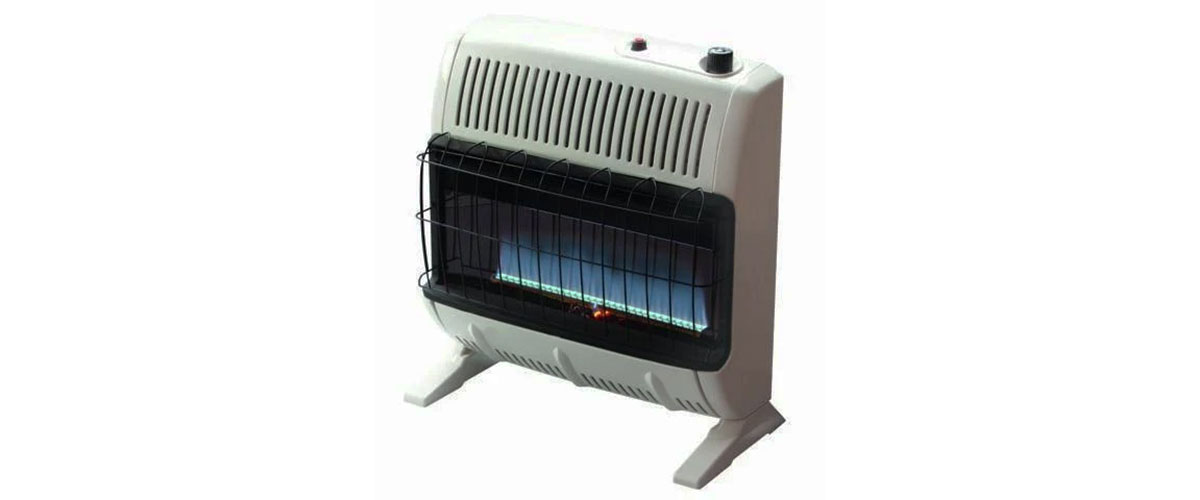
Using the technology of a blue-flame tube burner, Mr. Heater VF30KBLUELP relies on natural convection to cleanly burn liquid propane and then circulate comfortable, warm air. By delivering 30,000 BTU per hour, this heater is suitable for garages of around 1,000 square feet. It consumes 1.389 lbs per hour and ensures 14 hours of operation time on a full 20# propane cylinder.
Similar to Dyna-Glo GBF30DTDG-2, this model also has a thermostat to get a comfortable temperature. Additional features include an oxygen depletion sensor, a high limit safety shut-off, and more. You don’t need electricity to start this device with a battery-powered electronic ignition.
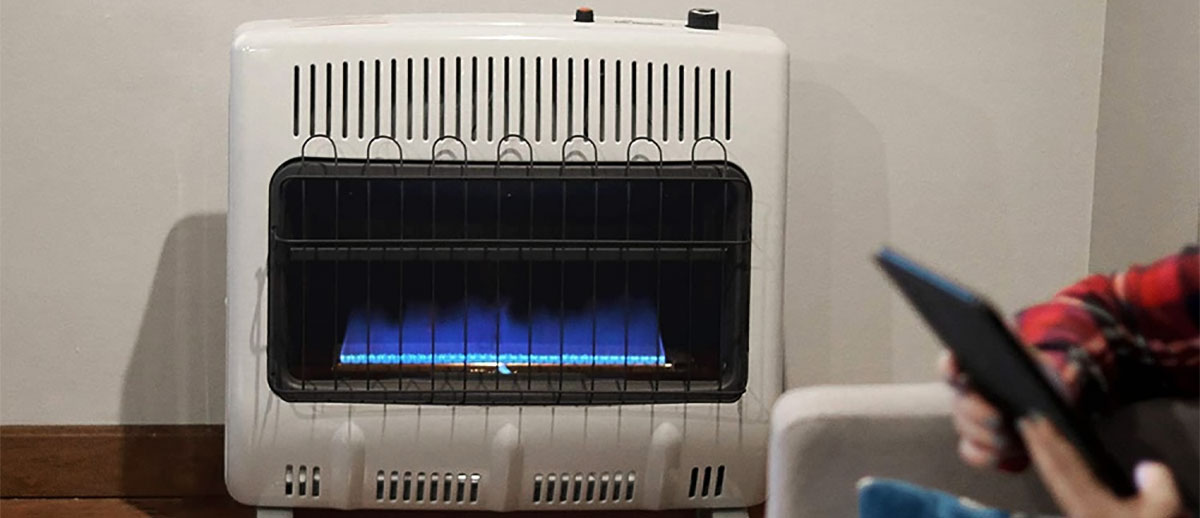
It heats the attached garage well, producing nearly no sound or gas smell. The standard blower is fine, but it looks a little wimpy. If you want it to move more air, you’ve got to get an extra fan. The thermostat doesn’t allow precise adjustments, and the low and high positions make no difference.
Weighing all pros and cons, the Mr. Heater VF30KBLUELP is the best ventless garage heater. It works flawlessly even at the lowest temperature and can be started even in conditions of a power outage.
Key specs
- Fuel type: propane
- Heating area, sq.ft: 1000
- Heating capacity, BTU: 30000
- Heat type: blue flame
- Mounting: floor, wall mounting
- Weight, lbs/kg: 26.8/12.1
Pros
- Suitable for 1,000 square feet garages by delivering 30,000 BTU
- Quiet and emits no propane smell
- Ensures 14 hours of operation
- Easy to start even without electricity.
Cons
- The blower might require an upgrade
- The thermostat might be hard to adjust.
Dyna-Glo GBF30DTDG-2
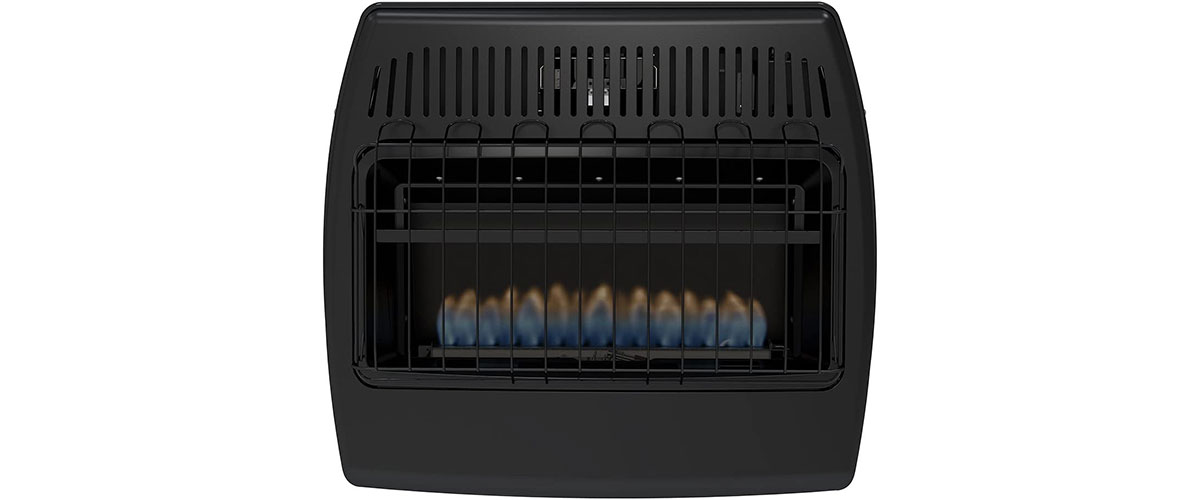
Being a blue-flame heater, the Dyna-Glo GBF30DTDG-2 works pretty much the same as the central heating system. It heats up the garage of 1,000 square feet by delivering 30,000 BTU per hour. This model is suitable for emergencies such as power outages since it doesn’t require electricity.
Unlike Mr. Heater VF30KBLUELP propane heater, this device features a dual-fuel system, supporting LP gas, natural gas, and propane. You can easily switch between the fuel options using a knob.
The Dyna-Glo GBF30DTDG-2 heater warms the one-car garage even during the coldest winter days. There is no gas smell as it is running, and the thermostat makes it easier to regulate how hot or cold you would like the air to be. The fuel tank lasts long (you will need around 60-70 lbs of fuel for the entire winter).
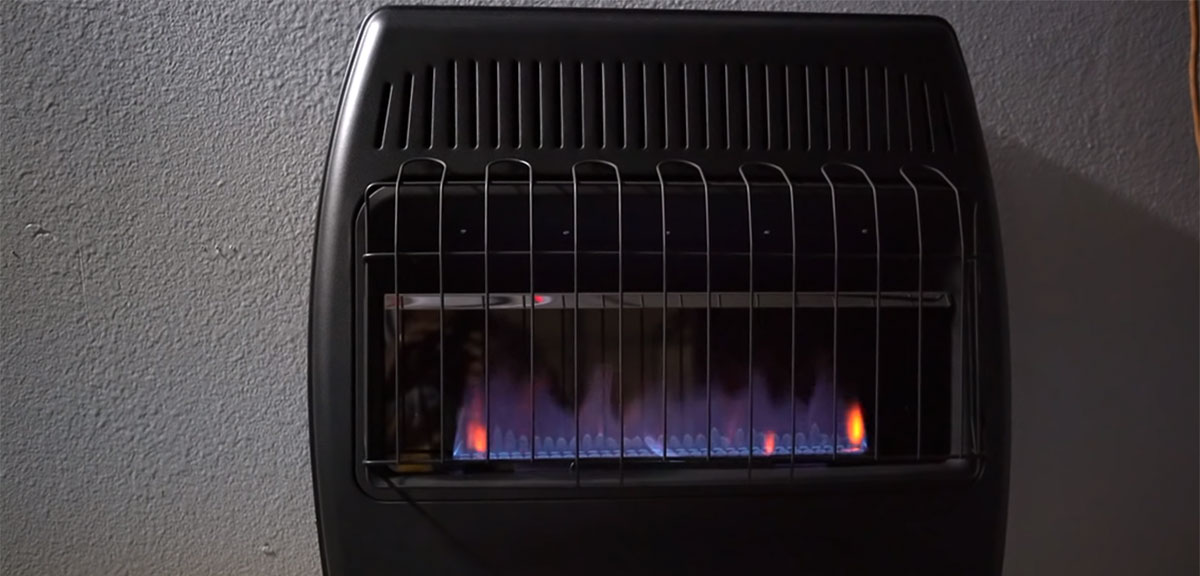
But installing this heater is a bit of a mess and might require you to hire a professional plumber. It also might malfunction over time. The pilot light may stay on for around 30-40 minutes and then turn off, allowing no fuel to flow out.
This ventless propane & gas garage heater will keep the chill out of your garage. It supports two fuel options and doesn’t consume much gas or propane to warm up the air.
Key specs
- Fuel type: propane, natural gas
- Heating area, sq.ft: 1000
- Heating capacity, BTU: 30000
- Heat type: blue flame
- Mounting: floor, wall mounting
- Weight, lbs/kg: 28/12.7
Pros
- A dual-fuel heater that supports natural gas and propane
- Suitable for 1,000 square feet garages
- No gas smell while it operates
- The thermostat is easy to regulate.
Cons
- It might be hard to install
- Can malfunction over time.
Mr. Heater MHVFRD10LP – smallest
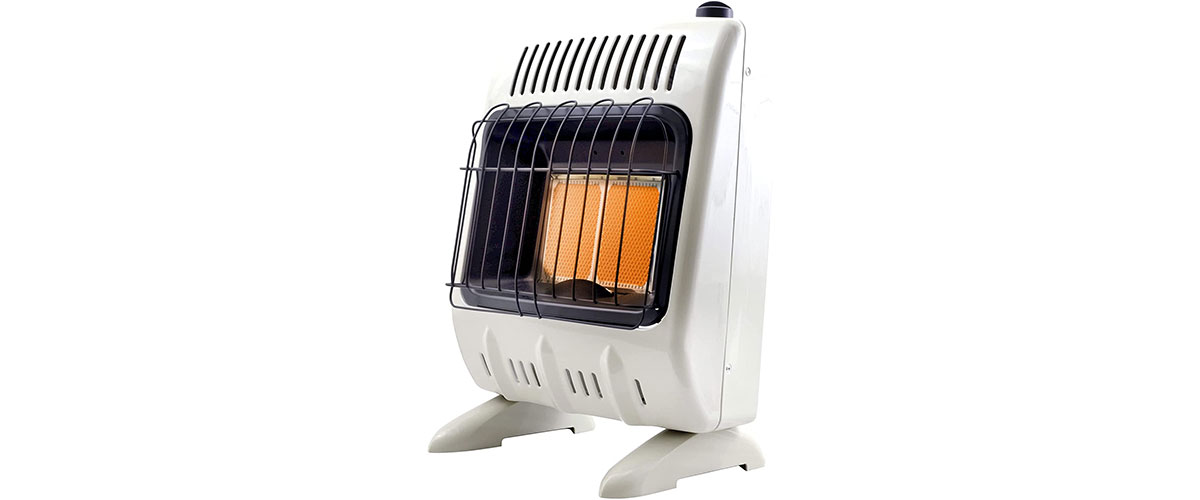
If you don’t have a big garage, you might satisfy your heating needs with this Mr. Heater MHVFRD10LP propane heater.
Unlike Mr. Heater VF30KBLUELP with the 30,000 BTU capacity, this model of the same brand produces only 10,000 BTU to heat the space of 300 square feet. Because this is a radiant type, the heat output might be enough to keep you warm.
By consuming 0.46 lbs fuel per hour, this device will ensure 43 hours of operation at the maximum BTU capacity. With the piezo ignition function, it’s a breeze to start this heater.
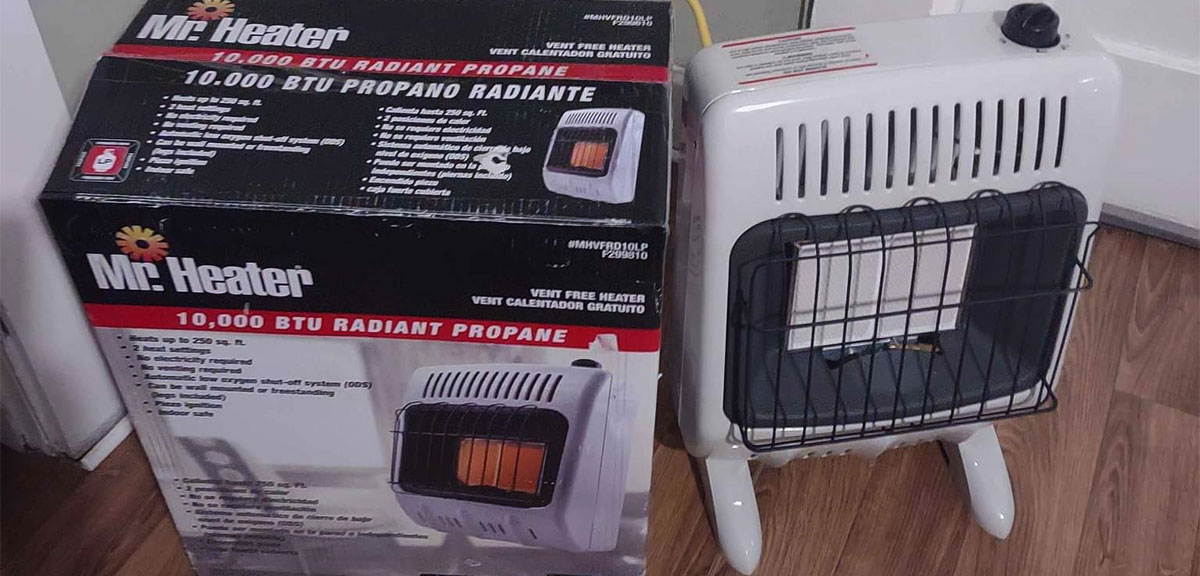
When purchasing this heater, you won’t find the thermostat, the hose, or the regulator. There are only two heat level settings: low and high, which might not be enough if you appreciate more customization. The Mr. Heater MHVFRD10LP produces strong heat, but it might take some time for the heating elements to get to the desired temperature.
Being the smallest ventless heater on my list, the Mr. Heater MHVFRD10LP still takes a decent place in the rating. It is the wisest solution for a small garage or if you tend to work in a particular spot.
Key specs
- Fuel type: propane
- Heating area, sq.ft: 300
- Heating capacity, BTU: 10000
- Heat type: radiant
- Mounting: floor, wall mounting
- Weight, lbs/kg: 17.7/8
Pros
- The radiant heating system keeps you warm
- Best suitable for small garages or warming particular spots
- Delivers 43 hours of operation on a full tank.
Cons
- No thermostat and only two heat level settings, which cuts customization
- Doesn’t come with a hose for connecting to the propane tank
- Takes time to fully get heated.
Best ventless natural gas heaters for garage reviews
Mr. Heater MHVFB30NGT – best gas heater
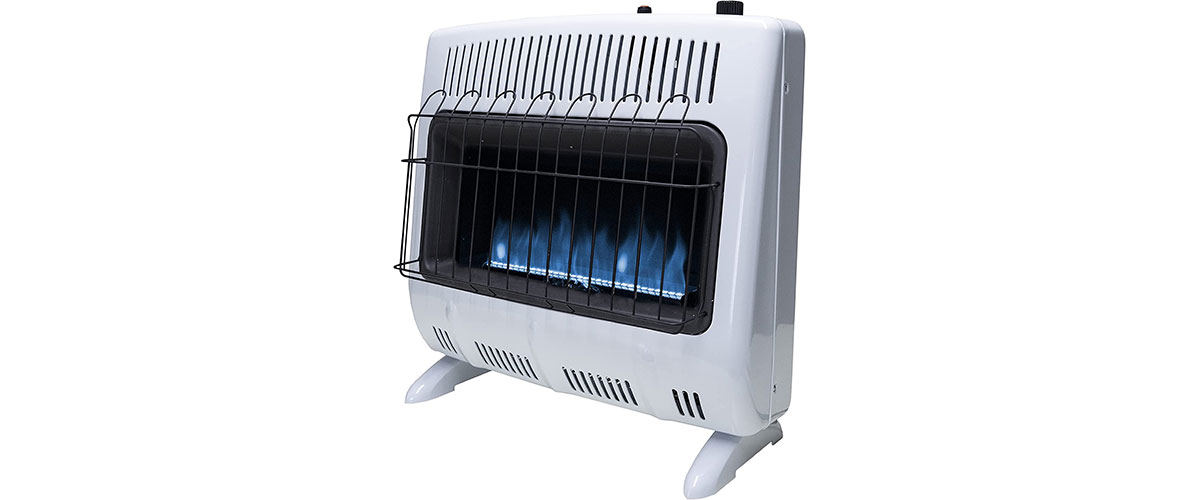
Feel comfy in your garage even when the winter comes with the Mr. Heater MHVFB30NGT blue-flame natural gas heater.
Extracting 30,000 BTU per hour is suitable for 1,000 square feet of one-car or two-car garages. This item consumes around 0.03 gallons per hour. It can be mounted to the wall or fastened to the floor using included brackets and fasteners.
Unlike the radiant Mr. Heater MHVFRD30NGT unit, this device features a blue-flame heating system that allows warming the air consistently throughout the whole garage.

This heater model comes with a thermostat for temperature control but doesn’t have a blower kit, hose, and regulator. Thus, you might need to invest some more money to make full use of the device. Also, I recommend you check the pipe joints as you install the heater to ensure there is no gas leakage (I noticed a faint scent of gas as I started the heater, which then disappeared).
Overall, the Mr. Heater MHVFB30NGT heater is efficient and does the heating job in the garage without flaws. It’s the best ventless natural gas garage heater due to its performance, ease of use, and reliability.
Key specs
- Fuel type: natural gas
- Heating area, sq.ft: 1000
- Heating capacity, BTU: 30000
- Heat type: blue flame
- Mounting: floor, wall mounting
- Weight, lbs/kg: 26.8/12.1
Pros
- Teliminates 30,000 BTU, which is sufficient for 1,000 square feet garages
- Can be mounted to the wall or placed on the floor
- Has a thermostat to control the temperature.
Cons
- Doesn’t have a blower kit and other details like the hose and regulator
- The faint scent of gas might be noticed.
Mr. Heater MHVFRD30NGT
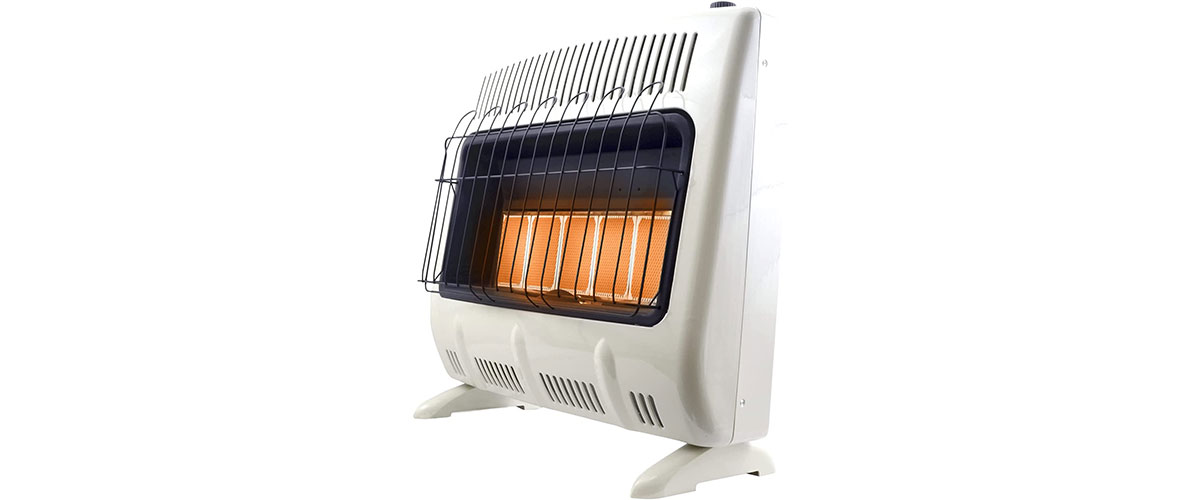
The Mr. Heater MHVFRD30NGT heater is the economical supplemental heating solution for your garage.
Just like the Mr. Heater MHVFB30NGT model, this device uses natural gas to produce heat. But instead of circulating cold and warm air, this one features a radiant heat burner to focus heat in a particular spot by warming the objects located directly in front of the heater.
Featuring 30,000 BTU capacity and covering 1,000 square feet, this is a great choice for a compact attached garage. A thermostat allows automatic temperature control and an electric ignition mechanism enables you to turn the heater on quickly.
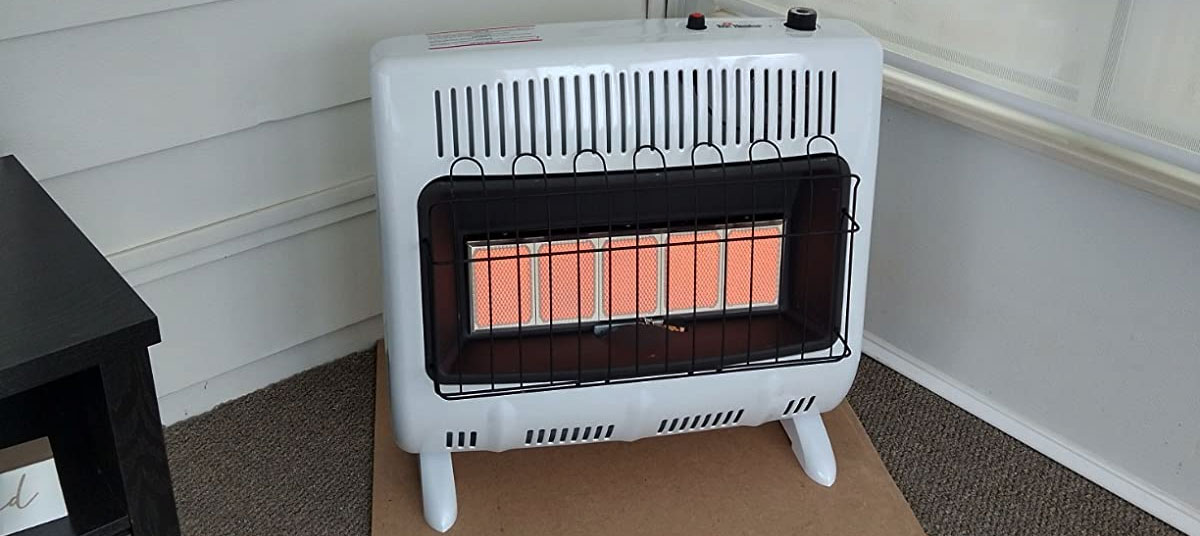
You might hear loud cracking noises if you over-tighten the lower mounting bolts when the device is running, so be careful during the installation. Also, the auto shut-off feature meant to protect the device from overheating might act out. The pilot light completely shuts off from time to time, and I’ve got to relight it, which I don’t really like.
Generally, this heater will keep you warm while you work in the garage. It heats up quickly and produces a steady stream of heat to the place where you are working..
Key specs
- Fuel type: propane
- Heating area, sq.ft: 1000
- Heating capacity, BTU: 30000
- Heat type: radiant
- Mounting: floor, wall mounting
- Weight, lbs/kg: 24.8/11.2
Pros
- Effectively heats the space around it (1,000 sq. ft.)
- Produces 30,000 BTU for maintaining a comfy temperaturer
- A thermostat allows controlling the temperature.
Cons
- Produces a loud noise when you over-tighten the mounting bolts
- The auto shut-off feature fails sometimes.
Ventless garage heaters buying guide
Heating capacity
The heating capacity defines how much heat the device will produce and is measured in BTU, a British thermal unit.
You might assume that the higher BTU, the better. This makes sense, but only if you have a large garage. A powerful heater used in a tiny space will do more harm than good as it will produce more carbon monoxide, which might be dangerous in an unventilated garage.
An average attached one- or two-car garage will require around 10,000-30,000 BTU. But you can make your own calculations based on the garage space considering that the optimal heat output is 25,000 BTU per 1,000 square feet.
Floor or wall mounting
There are freestanding and mounted units. You can position freestanding heaters anywhere in the garage and move them around. This might be especially beneficial if you use a less powerful heater for a big garage.
Mounted heaters are installed on the wall. The heater won’t stand in your way, but make certain you get a unit that is powerful enough to warm the whole garage without cold spots.
Built-in thermostat and ignition method
Ventless garage heaters with thermostats allow you to regulate the level of heat the device produces.
The heaters also have various ignition methods – automatic (electric) and manual. A piezoelectric ignition system is the most popular among electric ignition methods, and it produces a spark that ignites the fuel, making them super easy to start and operate. They might go out of order over time and require a replacement of the igniter. Manually ignited heaters are more reliable but might take some effort from your side to manually set the heater into work.
Safety features
Propane and natural gas vent-free heaters are some of the safest devices as they burn cleanly and cause little pollution. Other enhanced safety features such as auto shut-off when the item gets overheated, a carbon monoxide detector for tracking the emission level, child safety locks, and more help reduce the risk of accidents.
Installing a ventless garage heater
Choose the location for your ventless garage heater wisely. You may want to hang it on the outside wall to keep the propane tank outside. If you have a gas heater, place it as close to the gas supply as possible to be able to attach the unit to it with the hose.
Use the hole-producing drill to make the hole for the propane hose. Drill the screws into the wall and hang the heater. Make sure it is secure and level. Connect the hose attached to the fuel tank with the heater.








